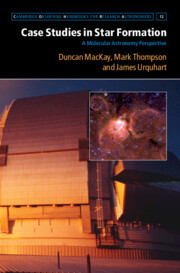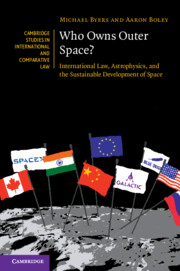Refine listing
Actions for selected content:
16950 results
15 - The Horsehead Nebula in Orion
- from Part V - Photodissociation
-
- Book:
- Case Studies in Star Formation
- Published online:
- 11 April 2023
- Print publication:
- 13 April 2023, pp 236-252
-
- Chapter
- Export citation
3 - IRAS 16293 in Ophiuchus
- from Part II - Low-Mass Star Formation (LMSF)
-
- Book:
- Case Studies in Star Formation
- Published online:
- 11 April 2023
- Print publication:
- 13 April 2023, pp 46-71
-
- Chapter
- Export citation
Part V - Photodissociation
-
- Book:
- Case Studies in Star Formation
- Published online:
- 11 April 2023
- Print publication:
- 13 April 2023, pp 203-204
-
- Chapter
- Export citation
Part I - Introduction
-
- Book:
- Case Studies in Star Formation
- Published online:
- 11 April 2023
- Print publication:
- 13 April 2023, pp 1-2
-
- Chapter
- Export citation
Frontmatter
-
- Book:
- Case Studies in Star Formation
- Published online:
- 11 April 2023
- Print publication:
- 13 April 2023, pp i-iv
-
- Chapter
- Export citation
13 - ATLASGAL PDRs
- from Part V - Photodissociation
-
- Book:
- Case Studies in Star Formation
- Published online:
- 11 April 2023
- Print publication:
- 13 April 2023, pp 205-215
-
- Chapter
- Export citation
2 - Two LMSFR Surveys Using IRAM and ALMA
- from Part II - Low-Mass Star Formation (LMSF)
-
- Book:
- Case Studies in Star Formation
- Published online:
- 11 April 2023
- Print publication:
- 13 April 2023, pp 27-45
-
- Chapter
- Export citation
Contents
-
- Book:
- Who Owns Outer Space?
- Published online:
- 06 April 2023
- Print publication:
- 13 April 2023, pp vii-vii
-
- Chapter
-
- You have access
- Open access
- HTML
- Export citation
List of Acronyms
-
- Book:
- Case Studies in Star Formation
- Published online:
- 11 April 2023
- Print publication:
- 13 April 2023, pp xv-xvi
-
- Chapter
- Export citation
Appendices
-
- Book:
- Case Studies in Star Formation
- Published online:
- 11 April 2023
- Print publication:
- 13 April 2023, pp 295-298
-
- Chapter
- Export citation
Copyright page
-
- Book:
- Who Owns Outer Space?
- Published online:
- 06 April 2023
- Print publication:
- 13 April 2023, pp iv-iv
-
- Chapter
-
- You have access
- Open access
- HTML
- Export citation
Figures
-
- Book:
- Who Owns Outer Space?
- Published online:
- 06 April 2023
- Print publication:
- 13 April 2023, pp viii-ix
-
- Chapter
-
- You have access
- Open access
- HTML
- Export citation

Case Studies in Star Formation
- A Molecular Astronomy Perspective
-
- Published online:
- 11 April 2023
- Print publication:
- 13 April 2023

Who Owns Outer Space?
- International Law, Astrophysics, and the Sustainable Development of Space
-
- Published online:
- 06 April 2023
- Print publication:
- 13 April 2023
-
- Book
-
- You have access
- Open access
- Export citation
9 - Ex-Stars
-
- Book:
- Stellar Structure and Evolution
- Published online:
- 02 May 2023
- Print publication:
- 06 April 2023, pp 209-230
-
- Chapter
- Export citation
2 - Tensors
-
- Book:
- A General Relativity Coursebook
- Published online:
- 03 May 2023
- Print publication:
- 06 April 2023, pp 19-42
-
- Chapter
- Export citation
4 - Stellar Energy Transport
-
- Book:
- Stellar Structure and Evolution
- Published online:
- 02 May 2023
- Print publication:
- 06 April 2023, pp 64-88
-
- Chapter
- Export citation
9 - A Guide to Further Reading
-
- Book:
- A General Relativity Coursebook
- Published online:
- 03 May 2023
- Print publication:
- 06 April 2023, pp 179-191
-
- Chapter
- Export citation
Reviews
-
- Book:
- A General Relativity Coursebook
- Published online:
- 03 May 2023
- Print publication:
- 06 April 2023, pp ii-ii
-
- Chapter
- Export citation
3 - Matter in Space-Time
-
- Book:
- A General Relativity Coursebook
- Published online:
- 03 May 2023
- Print publication:
- 06 April 2023, pp 43-52
-
- Chapter
- Export citation
